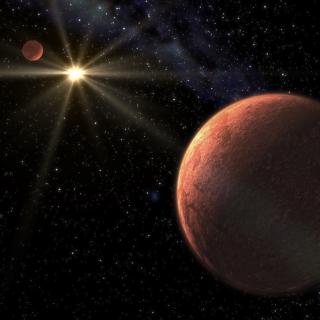Bibcode
Schweitzer, A.; Passegger, V. M.; Cifuentes, C.; Béjar, V. J. S.; Cortés-Contreras, M.; Caballero, J. A.; del Burgo, C.; Czesla, S.; Kürster, M.; Montes, D.; Zapatero Osorio, M. R.; Ribas, I.; Reiners, A.; Quirrenbach, A.; Amado, P. J.; Aceituno, J.; Anglada-Escudé, G.; Bauer, F. F.; Dreizler, S.; Jeffers, S. V.; Guenther, E. W.; Henning, T.; Kaminski, A.; Lafarga, M.; Marfil, E.; Morales, J. C.; Schmitt, J. H. M. M.; Seifert, W.; Solano, E.; Tabernero, H. M.; Zechmeister, M.
Bibliographical reference
Astronomy and Astrophysics, Volume 625, id.A68, 16 pp.
Advertised on:
5
2019
Journal
Citations
185
Refereed citations
173
Description
Aims: We determine the radii and masses of 293 nearby, bright M
dwarfs of the CARMENES survey. This is the first time that such a large
and homogeneous high-resolution (R > 80 000) spectroscopic survey has
been used to derive these fundamental stellar parameters.
Methods: We derived the radii using Stefan-Boltzmann's law. We obtained
the required effective temperatures Teff from a spectral
analysis and we obtained the required luminosities L from integrated
broadband photometry together with the Gaia DR2 parallaxes. The mass was
then determined using a mass-radius relation that we derived from
eclipsing binaries known in the literature. We compared this method with
three other methods: (1) We calculated the mass from the radius and the
surface gravity log g, which was obtained from the same spectral
analysis as Teff. (2) We used a widely used infrared
mass-magnitude relation. (3) We used a Bayesian approach to infer
stellar parameters from the comparison of the absolute magnitudes and
colors of our targets with evolutionary models. Results: Between
spectral types M0 V and M7 V our radii cover the range 0.1
R⊙ < R < 0.6 R⊙ with an error of
2-3% and our masses cover 0.09 ℳ⊙ <ℳ< 0.6ℳ⊙ with an error of 3-5%. We find
good agreement between the masses determined with these different
methods for most of our targets. Only the masses of very young objects
show discrepancies. This can be well explained with the assumptions that
we used for our methods.
Table B.1 (stellar parameters) is only available at the CDS via
anonymous ftp to http://cdsarc.u-strasbg.fr
(ftp://130.79.128.5) or via http://cdsarc.u-strasbg.fr/viz-bin/qcat?J/A+A/625/A68
Related projects

Very Low Mass Stars, Brown Dwarfs and Planets
Our goal is to study the processes that lead to the formation of low mass stars, brown dwarfs and planets and to characterize the physical properties of these objects in various evolutionary stages. Low mass stars and brown dwarfs are likely the most numerous type of objects in our Galaxy but due to their low intrinsic luminosity they are not so
Rafael
Rebolo López

Exoplanets and Astrobiology
The search for life in the universe has been driven by recent discoveries of planets around other stars (known as exoplanets), becoming one of the most active fields in modern astrophysics. The growing number of new exoplanets discovered in recent years and the recent advance on the study of their atmospheres are not only providing new valuable
Enric
Pallé Bago